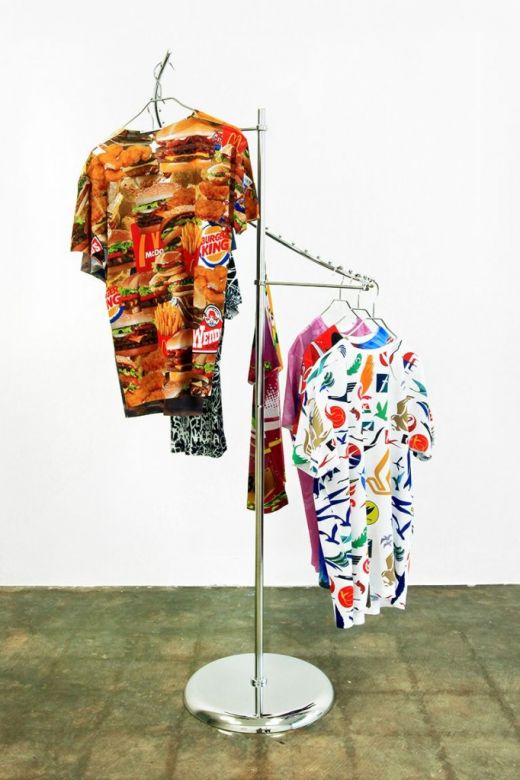Art404 IRL (In Real Life)
Amanda Sanfilippo

Art404, Maybe Legal Apparel [Pepsi vs Coke, A Flock of Airlines, Maybe Legal HD (purple one with audi rings), All Burger Everything, All Metal Everything, All Cute Everything (murakami/hello/kitty), All Intro Everything]. Custom printed t-shirts, chrome hangers, chrome spiral display stand, Dimensions Variable 2013. Photo Courtesy: Guccivuitton
APRIL 20-MAY 25, 2013 GUCCIVUITTON
With earnest fascination, we gathered around a laptop on a wall-mounted plinth in the back hallway of Guccivuitton, a Little Haiti gallery founded in April by three Miami-based artists. On the screen: multiple windows in a jagged parallelogram, inside which green code crawled downwards, multiplying in slow horror like the thing itself—a virus. We were watching a live hack, one happening of the entropic software that erodes the back end of luminous Internet experiences.
It requires thousands of computers performing the same task to force a “take down,” footnoted in the exhibition’s press release as a “denial-of-service attack,” i.e, unavailable page. Yet, rather than an empty threat, the disintegration witnessed in the hallway was a partial re-staging of an artwork already present in the exhibition, “Anonymous vs Art” (2012-2013). A digital print on stretchers, the piece depicts screen shots as simple proof of successful momentary attacks performed against corporate art world websites, including tate.org.uk and davidzwirner.com.
A feat of this magnitude, however insolent and elitist, is the product of a collaboration between Art404 and the infamous hacker group Anonymous, whose participants span the world in unification of anarchistic and anti-capitalist agency. In the spirit of friendly skill-sharing, the action produces an enigmatic truth of efficacy (“look what we did, what we can do”) that is both critical of the monetizing fervor of neo-liberal economics and a brash celebration of them.
Other works are similarly ambivalent and mutable, producing dimensionality in both their position and status as art objects, performances, documentation and/or ephemera. A rack of custom T-shirts featuring brand mish-mash in digital aesthetics is a sculpture, yet the tees are also sold as part of the artists’ exclusive fashion line. As Net or Post-Net art, the distinction opens up a stubborn and unexpectedly traditional conversation about medium specificity. Artworks created and designed to function and be experienced online are associated with the first term, where as Post-Net shares with the rapidly anachronizing New Aesthetic, describing a digital style which is extracted into tangible form.
Other works do not follow these rules at all: a large-scale projection, roughly 10 feet by 10 feet, loops a 5-ish minute “trailer.” The video, replete with scintillating audio, employs every trick in high-end cinema to lull viewers into the sense of comfort and anticipation as before watching a big budget movie, while at the same time jumbling brands, branding platforms and inserting content to reveal the tactics and our own susceptibility to them. The video, which turns out to be a high-def advertisement for their own status as artists through this particular language, is the splash page of Art404’s website. How and where does this material exist authentically? What does its permutation from one form to another do conceptually, aesthetically? As one of the Guccivuitton gallerists suggested, maybe it’s just as dumb as everything else is.










